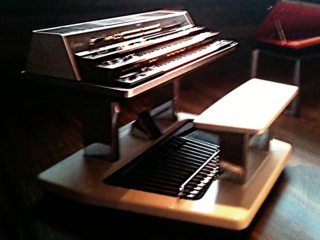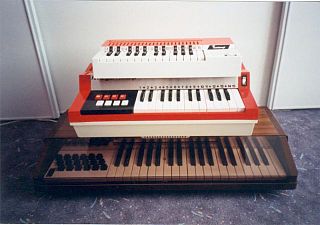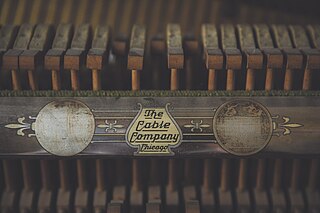Related Research Articles

Accordions are a family of box-shaped musical instruments of the bellows-driven free reed aerophone type. The essential characteristic of the accordion is to combine in one instrument a melody section, also called the diskant, usually on the right-hand keyboard, with an accompaniment or Basso continuo functionality on the left-hand. The musician normally plays the melody on buttons or keys on the right-hand side, and the accompaniment on bass or pre-set chord buttons on the left-hand side. A person who plays the accordion is called an accordionist.

An electronic musical instrument or electrophone is a musical instrument that produces sound using electronic circuitry. Such an instrument sounds by outputting an electrical, electronic or digital audio signal that ultimately is plugged into a power amplifier which drives a loudspeaker, creating the sound heard by the performer and listener.

The Hammond organ is an electric organ invented by Laurens Hammond and John M. Hanert and first manufactured in 1935. Multiple models have been produced, most of which use sliding drawbars to vary sounds. Until 1975, Hammond organs generated sound by creating an electric current from rotating a metal tonewheel near an electromagnetic pickup, and then strengthening the signal with an amplifier to drive a speaker cabinet. The organ is commonly used with the Leslie speaker.

A musical keyboard is the set of adjacent depressible levers or keys on a musical instrument. Keyboards typically contain keys for playing the twelve notes of the Western musical scale, with a combination of larger, longer keys and smaller, shorter keys that repeats at the interval of an octave. Pressing a key on the keyboard makes the instrument produce sounds—either by mechanically striking a string or tine, plucking a string (harpsichord), causing air to flow through a pipe organ, striking a bell (carillon), or activating an electronic circuit. Since the most commonly encountered keyboard instrument is the piano, the keyboard layout is often referred to as the piano keyboard or simply piano keys.

In music, the organ is a keyboard instrument of one or more pipe divisions or other means for producing tones. The organs have usually two or three, up to five, manuals for playing with the hands and a pedalboard for playing with the feet. With the use of registers, several groups of pipes can be connected to one manual.

An electronic keyboard, portable keyboard, or digital keyboard is an electronic musical instrument based on keyboard instruments. Electronic keyboards include synthesizers, digital pianos, stage pianos, electronic organs and digital audio workstations. In technical terms, an electronic keyboard is a rompler-based synthesizer with a low-wattage power amplifier and small loudspeakers.

Rodgers Instruments Corporation is an American manufacturer of classical and church organs. Rodgers was incorporated May 1, 1958 in Beaverton, Oregon by founders, Rodgers W. Jenkins and Fred Tinker, employees of Tektronix, Inc., of Portland, Oregon, and members of a Tektronix team developing transistor-based oscillator circuits. Rodgers was the second manufacturer of solid state oscillator-based organs, completing their first instrument in 1958. Other Rodgers innovations in the electronic organ industry include solid-state organ amplifiers (1962), single-contact diode keying (1961), reed switch pedal keying for pedalboards (1961), programmable computer memory pistons (1966), and the first MIDI-supported church organs (1986).

A rhythm section is a group of musicians within a music ensemble or band that provides the underlying rhythm, harmony and pulse of the accompaniment, providing a rhythmic and harmonic reference and "beat" for the rest of the band. The rhythm section is often contrasted with the roles of other musicians in the band, such as the lead guitarist or lead vocals whose primary job is to carry the melody.

An electric organ, also known as electronic organ, is an electronic keyboard instrument which was derived from the harmonium, pipe organ and theatre organ. Originally designed to imitate their sound, or orchestral sounds, it has since developed into several types of instruments:
C. G. Conn Ltd., Conn Instruments or commonly just Conn, is a former American manufacturer of musical instruments incorporated in 1915. It bought the production facilities owned by Charles Gerard Conn, a major figure in early manufacture of brasswinds and saxophones in the USA. Its early business was based primarily on brass instruments, which were manufactured in Elkhart, Indiana. During the 1950s the bulk of its sales revenue shifted to electric organs. In 1969 the company was sold in bankruptcy to the Crowell-Collier-MacMillan publishing company. Conn was divested of its Elkhart production facilities in 1970, leaving remaining production in satellite facilities and contractor sources.

Bass pedals are an electronic musical instrument with a foot-operated pedal keyboard with a range of one or more octaves. The earliest bass pedals from the 1970s consisted of a pedalboard and analog synthesizer tone generation circuitry packaged together as a unit. The bass pedals are plugged into a bass amplifier or PA system so that their sound can be heard. Since the 1990s, bass pedals are usually MIDI controllers, which have to be connected to a MIDI-compatible computer, electronic synthesizer keyboard, or synth module to produce musical tones. Some 2010s-era bass pedals have both an onboard synth module and a MIDI output.

The pump organ or reed organ is a type of free-reed organ that generates sound as air flows past a vibrating piece of thin metal in a frame. The piece of metal is called a reed. Specific types of pump organ include the American reed organ, the Indian harmonium, the physharmonica, and the seraphine. The idea for the free reed was derived from the Chinese sheng through Russia after 1750, and the first Western free-reed instrument was made in 1780 in Denmark.

Bontempi is an Italian musical instrument manufacturer, best known for manufacturing low-priced, plastic-cased chord organs: small keyboard instruments in which the sound is produced by air being forced over reeds by an electric fan.

Chord organ is a kind of home organ that has a single short keyboard and a set of chord buttons, enabling the musician to play a melody or lead with one hand and accompanying chords with the other, like the accordion with a set of chord buttons which was originated from a patent by Cyrill Demian in 1829, etc.

Allen Organ Company LLC builds church organs, home organs, and theatre organs. Its factory is located in Macungie, Pennsylvania. The Allen International Sales Headquarters also includes the Jerome Markowitz Memorial Center, a museum. It displays many instruments that represent technological milestones in the development of the pipeless, electronic organ.
A music store or musical instrument store is a retail business that sells musical instruments and related equipment and accessories. Some music stores sell additional services, such as music lessons, music instrument or equipment rental, or repair services.
Viscount International SpA (Viscount) is a musical instrument manufacturer based in Mondaino, Italy. The brand Viscount was registered in 1969 by Marcello Galanti, but the company was established in the late 19th century by his forefather Antonio Galanti. After 1969 Viscount's primary focus has been on classic organs and digital pianos. Several alternative brands were formed in the 2000s to aim at expanding into other markets: VERSE and Voice Systems, respectively, for the high and low-end Pro-Audio markets and Physis for digital organs using Viscount's physical modeling technology. The company also used the Oberheim brand for several years, to market vintage organs, synthesizers and guitar effects. Currently, Viscount's manufacturing and R&D activity is based in Italy. The company has been continuously owned by the Galanti family since its inception.

Gulbransen Company was a musical instrument manufacturer of player pianos and home organs in the United States. It also made reed organs. It was originally established in 1904 by Axel Gulbransen as Gulbransen Piano Company.

The Cable Company was an American manufacturer and distributor of pianos and reed organs that operated independently from 1880 to 1936.

Electric music technology refers to musical instruments and recording devices that use electrical circuits, which are often combined with mechanical technologies. Examples of electric musical instruments include the electro-mechanical electric piano, the electric guitar, the electro-mechanical Hammond organ and the electric bass. All of these electric instruments do not produce a sound that is audible by the performer or audience in a performance setting unless they are connected to instrument amplifiers and loudspeaker cabinets, which made them sound loud enough for performers and the audience to hear. Amplifiers and loudspeakers are separate from the instrument in the case of the electric guitar, electric bass and some electric organs and most electric pianos. Some electric organs and electric pianos include the amplifier and speaker cabinet within the main housing for the instrument.
References
- ↑ Music Trades. Music Trades Corporation. 1988. Retrieved 15 September 2013.
- ↑ Retail Business: Market reports. EIU. July 1992. Retrieved 15 September 2013.
- ↑ Robert F. Gellerman (1998). Gellerman's international reed organ atlas. Vestal Press. ISBN 978-1-879511-34-7 . Retrieved 15 September 2013.